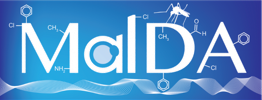Reaction hijacking of tyrosine tRNA synthetase as a new whole-of-life-cycle antimalarial strategy.
Journal:
Science (New York, N.Y.), Volume: 376, Issue: 6597Abstract:
Aminoacyl transfer RNA (tRNA) synthetases (aaRSs) are attractive drug targets, and we present class I and II aaRSs as previously unrecognized targets for adenosine 5′-monophosphate-mimicking nucleoside sulfamates. The target enzyme catalyzes the formation of an inhibitory amino acid-sulfamate conjugate through a reaction-hijacking mechanism. We identified adenosine 5′-sulfamate as a broad-specificity compound that hijacks a range of aaRSs and ML901 as a specific reagent a specific reagent that hijacks a single aaRS in the malaria parasite , namely tyrosine RS (YRS). ML901 exerts whole-life-cycle-killing activity with low nanomolar potency and single-dose efficacy in a mouse model of malaria. X-ray crystallographic studies of plasmodium and human YRSs reveal differential flexibility of a loop over the catalytic site that underpins differential susceptibility to reaction hijacking by ML901.
